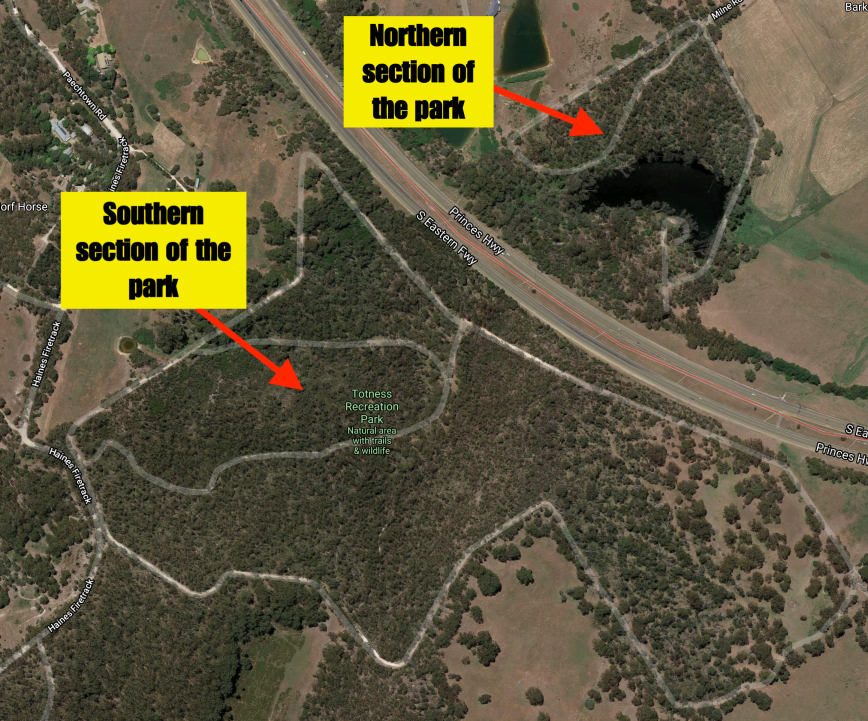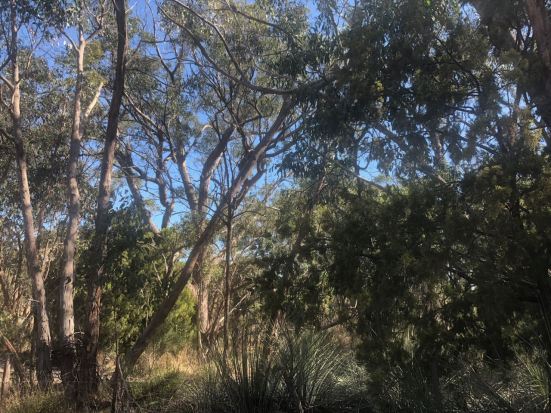For a variety of different reasons, I have not activated a park since the start of December 2019. Today (Sunday 15th March 2020) was a beautiful sunny day so I decided to motivate myself and head out for a park activation. I chose my local park, the Totness Recreation Park VKFF-1754.
Totness is just a short drive from my home, and as a result, I have activated Totness many times before. The park is located about 40 km south-east of Adelaide in the Mount Lofty Ranges ‘Adelaide Hills’.

Above:- Map showing the location of the Totness Recreation Park. Map courtesy of Google maps.
Totness Recreation Park is about 41 hectares (101 acres) in size and was established on the 15th day of January 1970. The park is dissected by the South Eastern Freeway (the main road between Adelaide and Melbourne). The park is surrounded by rural properties that are primarily used for grazing.
Although it is designated as a Recreation Park, Totness has no visitor facilities. There are walking trails in the park. The park is not signposted nor is there a lot of parking options. Access to the park is either via Haines Fire Track for the southern section or Milne Road for the northern section. Milne Road runs off Mount Barker Road.
The land that is now Totness Recreation Park was formerly the property of the South Australian Railways and the Department of Transport. The park was declared as the Totness National Parks Reserve on the 15th day of January 1970 and was re-designated as a recreation park on the 27th day of April 1972.

Above:- An aerial view of the Totness Recreation Park looking west towards the city of Adelaide. Image courtesy of Google maps.
The park takes its name from the area of Totness, which was named by William Hannaford (1825-1869) when he cut up section 2963 Hundred of Macclesfield in 1961. He issued seventy-year leases with right of purchase which commenced in 1871. Hannaford was born in Totnes Devon in 1825. He emigrated to Australia aboard the Emma in 1845. The surrounding area was as known as Little Totness.
The town of Totnes in Devon, England is a small market town located at the head of the estuary of the River Dart. The town has a long recorded history dating back to 907 when its first castle was built. The spelling of the town is Totnes, unlike Totness in South Australia.

OLYMPUS DIGITAL CAMERA
During the late 1800s and early 1900s, the wattle bark industry flourished in the vicinity of the park. Stringybark trees were cut for firewood. The nearby Mount Barker Tannery utilised the wattle bark for tanning leather and the firewood was used in steam boilers and brick kilns.
A significant portion of the southern section of the park was land which was originally granted to John Dunne in 1853. Dunne was a significant figure in the early history of the town of Mount Barker.

Above:- John Dunne. Image courtesy of WIkipedia
Over 180 native plant species can be found in the park including messmate stringybark and manna gum woodlands which are now uncommon in much of their former range across the Mount Lofty Ranges.
Numerous native mammals can be found in the park including Western Grey kangaroos, Common ringtail possums, short-beaked echidnas and koalas. Feral Fallow Deer can also be found in the park.
Birds SA have recorded about 57 species of bird in the park including Superb Fairywren, Striated Thornbill, Brown Thornbill, Buff-rumped Thornbill, Grey Shrike-thrush, Australian Golden Whistler, White-throated Treecreeper, Eastern Spinebill, Yellow-rumped Thornbill, and Red-browed Finch.
In the northern section of the park you can find an old South Australian Railways dam. The dam was built in 1884 and was used until 1944 to provide water to the steam trains which travelled through Mount Barker from Adelaide to the seaside town of Victor Harbor. Water was piped to an outlet at the Mount Barker Railway Station about 5 km away. The dam also previously provided water for Mount Barker residents until 1955 with the commission of the Mannum-Adelaide pipeline. Today, the dam is popular for fishing for Redfin.

Above:- An aerial shot of the Totness Recreation Park showing the northern and southern sections dissected by the South Eastern Freeway. Image courtesy of google maps.
I set up in my normal spot which is off Haines Firetrack. There is a small area here where you can park your car without blocking the gate. I set up my fold up table and deck chair just inside the gate and I ran the Yaesu FT-857d and the 20/40/80m linked dipole for the activation.
I called CQ on 7.144 and first in the log was Brenton VK3CM with a very strong 5/9 plus signal. This was followed by Dennis VK2HHA, Colin VK3NQS and then Malcolm VK3OAK/p who was operating portable in the Mount Erip Flora Reserve VKFF-2397.
I went on to work a total of 39 stations on 40m including two further Park to Park contacts. One with Adam VK2YK/5 who was in the Cobbler Creek Recreation Park VKFF-1699, and the other with John VK5HAA/p who was in the Kenneth Stirling Conservation Park VKFF-0781. I also logged Peter VK3PF/p and Ross VK3NRB who were activating SOTA peak, Mount Shillinglaw.
When callers slowed down I had a tune across the 40m band and I found special event station VI3RA calling CQ on 7.160. Over this weekend the Shepparton and District Amateur Radio Club with the kind permission of BAI Communications (Broadcast Australia) will connect amateur transceivers to the curtain array and rhombic antennas at the Broadcast Australia site in Shepparton which is located in North Central Victoria Australia. This site was previously a Radio Australia location which was the Shortwave Service from Australia. The Radio Australia transmissions from this site ceased in 2017.
After logging VI3RA I moved up to the 20m band and started calling CQ on 14.310. Murray VK4MWB came back to my CQ call with a strong 5/8 signal. Andrei ZL1TM then called in and although he was a weak signal, he made my log. Unfortunately, they were my only 2 callers on 14.310.

I then headed down to the ANZA DX Net on 14.183, but sadly they were just closing the net. Net control Mike VK4JT kindly allowed me to give Alberto P29LL in Papua New Guinea a call. Alberto was 5/8 and he gave me a 5/5 signal report. Once the net had closed I logged a handful of stations on 14.183 including Ted VK6NTE with his normal big signal, Clem VK4XCS, and Greg VK4VXX.
I then moved to the 80m band where I logged Darryl VK5JDS and Joseph VK5WU. To conclude the activation I moved back to 40m where I logged a further 8 stations on 7.130. I couldn’t get back to 7.144 as the 40m band was very busy with a number of European stations. I was also privileged to be called by Rex VK3OF who was at the mic of VI3RA. Rex was instrumental in getting VI3RA on air.
THANK YOU to everyone who called me. It was my first activation for a long time, and I had a lot of fun out in the afternoon sun having a chat.
I worked the following stations on 40m SSB:-
- VK3CM
- VK2HHA
- VK3NQS
- VK3OAK/p (Mount Erip Flora Reserve VKFF-2397)
- VK3SQ
- VK3ZPF
- VK4NH
- VK4DXA
- ZL4TY/VK4
- VK4HNS
- VK2EXA/p
- VK4TJ
- VK4/AC8WN
- VK4/VE6XT
- VK4SSN
- VK3TKK/m
- VK2YK/5 (Cobbler Creek Recreation Park VKFF-1699)
- VK2WI
- VK3NBL
- VK4FDJL
- VK4FARR
- VK3CFA
- VK1MIC
- VK3SH
- VK3STU
- VK5HAA/p (Kenneth Stirling Conservation Park VKFF-0781)
- VK2LEE
- VK2KJJ
- VK2UXO
- VK5KBJ
- VK3PF/p (SOTA VK3/ VE-068)
- VK3NRB/p (SOTA VK3/ VE-068)
- VK4SMA
- VK3MAB
- VK4CZ
- VK4MWB
- VK4SYD
- VK5FMAZ
- VK3VDX
- VI3RA
- VK3HK
- VK3SX
- VK2IO
- VK4OY
- VK3HBG
- VK7HCK
- VI3RA
- VK3OF
- VK7PSJ
I worked the following stations on 20m SSB:-
- P29LL
- VK4JT
- VK4GSF
- VK6NTE
- VK4XCS
- VK4VXX
- VK4BXX
- VK4/NN3Z
I worked the following stations on 80m SSB:-
- VK5JDS
- VK5WU
References.
Birds SA, 2020, <https://birdssa.asn.au/location/totness-recreation-park/>, viewed 15th March 2020.
Department for Environment and Heritage, 2007, Totness Recreation Park Management Plan.
State Library South Australia, 2020, <https://published.collections.slsa.sa.gov.au/placenamesofsouthaustralia/T.pdf>, viewed 15th March 2020.
Wikipedia, 2020, <https://en.wikipedia.org/wiki/Totness_Recreation_Park>, viewed 15th March 2020.
Wikipedia, 2020, <https://en.wikipedia.org/wiki/Totnes>, viewed 15th March 2020.






























